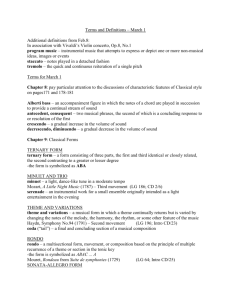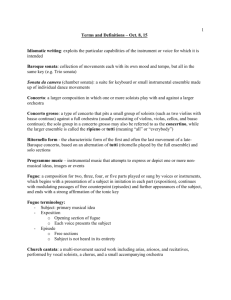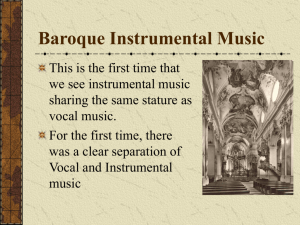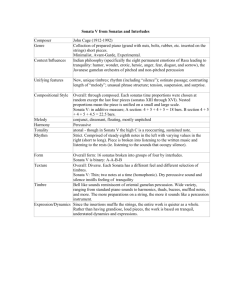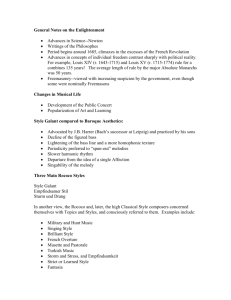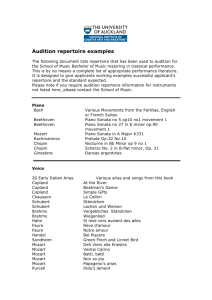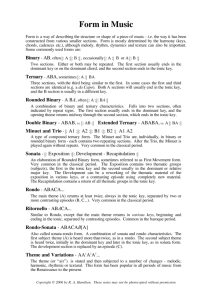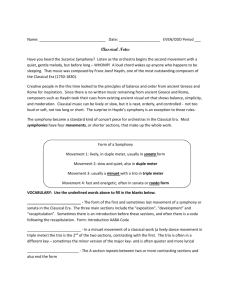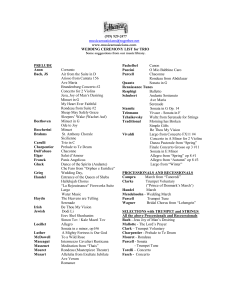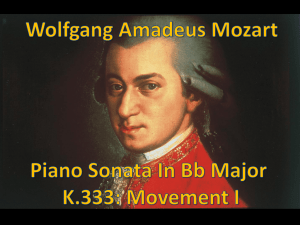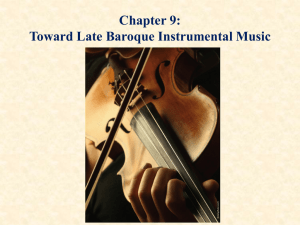The Enlightenment
advertisement
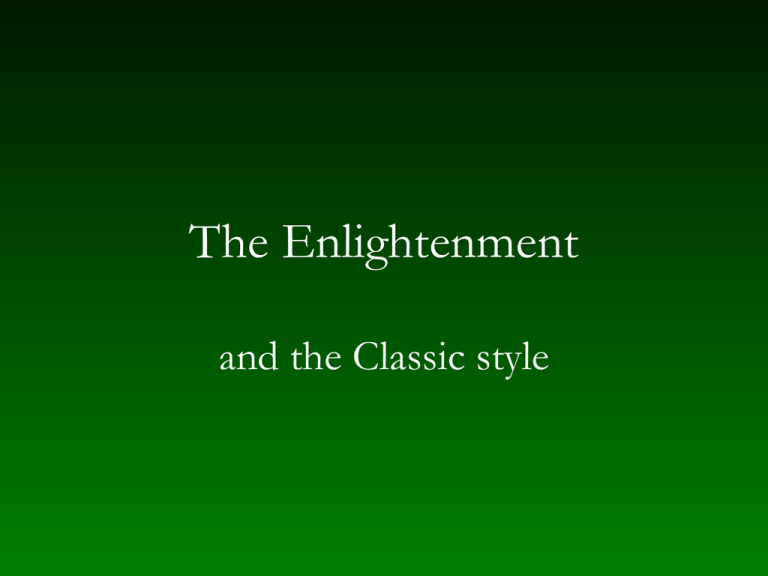
The Enlightenment and the Classic style Enlightenment as intellectual context for music • Builds on rationalism but tends away from it toward empiricism — deductive replaced by inductive thinking • Attempts to bring order to experience in various fields • Empirical science • Practical technology • Progressive political thought — empiricism leads to egalitarianism • Literature — novel brings plot to new importance The “classic” outlook • Term suggests standard or model, enduring value • Based on ideas of Classical Antiquity, specifically Apollonian spirit – clarity, simplicity – symmetry, balance, order – objectivity • Visual art imitates ancient models — “neoclassic” • Only partly applicable in music (no ancient models as for visual arts) Political and social contexts for music • Feudal system replaced by enlightened monarchy, e.g., – Frederick the Great in Prussia (r. 1740–1786) – Maria Theresia (r. 1740–1780), Joseph II (r. 1780–1790) in Austria • Aristocratic patronage important • Expansion of urban, commercial class – sales of music and instruments to amateur public – demand for teaching – concert series made music available to ticket buyers Comparison of musical careers — Haydn and Mozart Franz Joseph Haydn (1732–1809) Wolfgang Amadeus Mozart (1756–1791) • Nonmusical family — father was village wheel maker • Trained as Vienna choirboy • Poor gigging musician in his 20s • Thrived under patronage of Prince Nicholas Esterhazy • Musical family — father, Leopold, was important violinist • Trained by Leopold, traveled widely • Early international successes • Chafed under patronage in Salzburg, eventually independent in Vienna Opera reform in the mid–eighteenth century • Composers (and librettists) and audiences turning away from Metastasian artificiality and rhetorical excess • Viennese reform – Christoph Willibald Gluck (1714–1787) — composer – Raniero Calzabigi (1714–1795) — librettist • Ideals — outlined in Preface to Alceste – music to serve drama rather than the reverse – “beautiful simplicity” — classicist – “simplicity, truth, and naturalness” — Enlightenment Four-movement sonata plan Symphony, String quartet • Fast movement, tonic key, sonata form • Slow movement, usually subdominant or submediant key, various forms • Minuet, tonic key, composite ternary form • Fast movement, tonic key, sonata or rondo form Three-movement sonata plan Sonata, concerto • Fast movement, tonic key — sonata form or special variant for concerto • Slow movement, subdominant or submediant key, various forms • Fast movement, tonic key, sonata or rondo form Sonata form I. 1. P T ||: 2. S K :||: I – – →→ V – – – – V –I II. 3. 4. P T S K :|| →→ I – – – – – – – Sonata form in minor keys I. 1. P T ||: 2. S K II. 3. 4. P T S K :||: :|| i – – →→ III – – III →→ i – – – – – – – – i or I – – – I Rondo form Five-part Rondo — A I B A I C A I or A I B A I B A I Seven-part Rondo — A B A C A D A or A B A C A B A I I I I I I I I Concerto first-movement form (with integration of sonata and ritornello forms) Ritornello I. Tutti Rit. Solo 1. 2. 1P 2P K 1P T S/2P K II. Ritornello Tutti Solo Tutti Solo 3. Tutti 4. 1P T S/2P K [Cadenza] I – – – – – I I – – → V – – – V – – – V → → I – – – – – – – – I6/4 – – V7 I – – –I NB: The thematic outline shown is only an example. Different concertos have different thematic plans. “Topics” in eighteenth-century music Some examples of expressive tospos • Military • Singing — cantabile, aria • Dances – upper social classes — minuet, gavotte, – lower classes — contredanse, Ländler, rustic waltz • • • • • Ecclesiastical Empfindsam Sturm und Drang Hunt Brilliant Questions for discussion • How were ideals of the Enlightenment and neoclassicism reflected in music in the middle of the eighteenth century? • Why did Haydn’s and Mozart’s careers differ so strikingly? • What elements of the eighteenth-century symphony can be traced to roots in the preceding period’s style? • Given the importance of convention in eighteenthcentury music, what value should be placed on originality in music of the period, and how might the composer make her or his work original?
